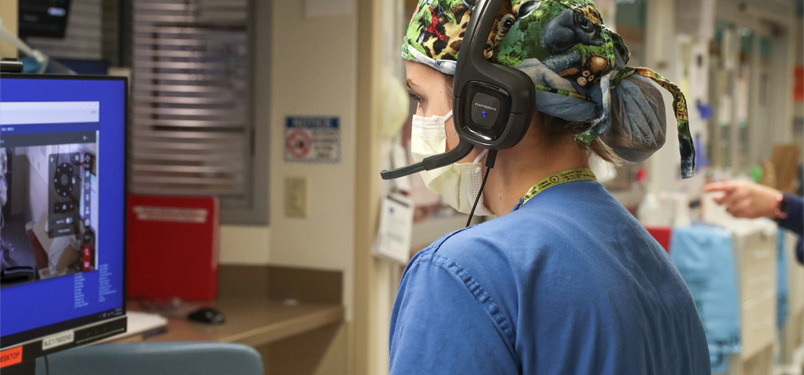BJC information services collaborates with tele-ICU to connect families during pandemic

Desperately ill in a Barnes-Jewish Hospital ICU, Jennifer McBride spent almost three weeks on a ventilator. The 45-year-old St. Louisan remembers telling herself that she had to fight the coronavirus attacking her lungs so she could see her sons again.
But COVID-19, which sent McBride to BJH, had caused hospitals across the region to restrict visitors. McBride’s only human contact was with her care team, who were covered head-to-toe in personal protective equipment.
Meanwhile, her sons, 24 and 16, waited at home — and worried. Although the hospital updated them regularly, they wanted to be near their mother to comfort and encourage her.
One day, McBride heard the voices of her oldest son and her sisters, Angela and Patricia, in the room with her. Opening her eyes wide, she could see them on the video screen near her bed, part of the equipment used by BJC tele-ICU doctors and nurses to remotely monitor critically ill patients.
Her son and sister told McBride they loved her and urged her to get well. Though she couldn’t talk, McBride managed a weak “thumbs up,” and her family cheered.
Being able to hear and see her family had reinforced McBride’s will to fight. Likewise, seeing her respond to their voices helped relieve her family’s anxiety.
With visitors restricted at BJC hospitals due to COVID-19, technology that started as a way to monitor critically ill patients is now helping patients spend precious time with family and friends.
Tele-ICU technology has been used by physicians and critical care nurses based at the Meridian Building to remotely monitor patient data and provide two-way audiovisual communication with the caregivers in ICUs across the organization.
Now, several BJC hospitals are employing this technology to provide a temporary video link between families and their loved ones in the ICU. The tele-ICU team collaborated with BJC information services to make each link unique and time-limited to ensure that it’s secure and complies with HIPAA regulations.
Allowing patients and their families to connect has helped calm the fears of loved ones while offering a healing boost to patients, says Julie Paul, BSN, CCRN, who rotates between the BJH COVID-19 ICU and tele-ICU. Paul helped with this expansion of tele-ICU technology.
“Spending weeks in an ICU with no visitors is very isolating for patients,” says Paul. “By necessity, we have to limit the time we spend in their room, and we’re all garbed up so all they see is our eyes. So, the level of human interaction they now receive over the cameras is very important in their recovery.”
McBride agrees. Being able to see and hear her children gave her a boost and renewed her determination to get well. After 20 days on a ventilator, she was extubated and moved to a regular hospital room, with ICU staff cheering as she was rolled out. She was discharged to home shortly afterward, where she continues to recover.
The technology has even been used to allow patients who don’t recover to spend their last moments connected to loved ones.
Tele-monitoring has also become an important safety and infection prevention tool by helping to limit the number of times a caregiver must enter a COVID-19 patient’s room. The video feed from the patient’s room allows ICU staff to view important visual cues, such as the levels of IV fluids, medication doses and ventilator settings. They can even communicate with the patient prior to entering the room. And, fewer bedside visits help conserve personal protective equipment.
BJC hospitals also recently began using the Zoom app on iPads to conduct tele-visits with COVID-19 patients. In addition to the caregiver team, spiritual care, palliative care, social work and other team members are connecting with patients using the technology.
Paul estimates that the teams in the Barnes-Jewish 8400 ICU, BJC’s largest ICU, assisted by staff from spiritual care and social work, spend a cumulative three to four hours each day coordinating sessions between ICU patients and their families.
The effect these virtual visits have on the staff who facilitate them is an additional benefit.
“It’s very satisfying to know we can provide this level of comfort to families at this difficult time,” says Lisa Konzen, BSN, MA, CCRN-E, BJC tele-ICU director.
Jennifer Carron, BJH executive director for patient experience, agrees that being able to connect critically ill patients with the emotional support they need benefits caregivers as well as patients.
“From the very young to the very old, family and friends are able to be there to support recovery as well as end of life,” she says. “This is not only therapeutic for the patient and their loved ones, but also the care team who often act as surrogates when the family is not there.”
In a matter of weeks, the COVID-19 pandemic changed health care delivery. Expanded use of tele-ICU technology is a change that BJC caregivers want to keep.
“COVID-19 has brought unprecedented and challenging times. But as a result, we’ve learned new and innovative ways to better care for our patients and their families, now and in the future,” says Chris Palmer, MD, BJH tele-ICU co-medical director and Washington University assistant professor of emergency medicine/critical care. “This technology isn't going away and it adds hope.”
McBride’s sister, Patricia, who spent seven days being treated for COVID-19 in another hospital, agreed. “When you can't see or touch your loved one, it’s so hard on both the patient and family,” she says. “You know a doctor’s update is helpful, but seeing your loved ones and knowing they are okay — there's just nothing like that.”
- Resource